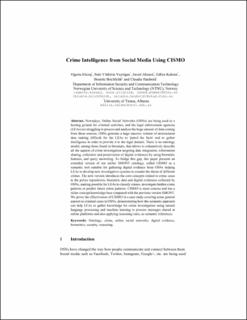| dc.description.abstract | Nowadays, online social networks (OSNs) are being used as a hosting ground for criminal activities, and the legal enforcement agencies (LEAs) are struggling to process and analyse the huge amount of data coming from these sources. OSNs generate a huge massive volume of unstructured data making it difficult for the LEAs to ‘patrol the facts’ and to gather intelligence in order to provide it to the legal domain. There is no ontology model, among those found in literature, that allows to exhaustively describe all the aspects of crime investigation targeting data integration, information sharing, collection and preservation of digital evidences by using biometric features, and query answering. To bridge this gap, this paper presents an extended version of our earlier SMONT ontology, called CISMO as a semantic tool suitable for gathering digital evidence from OSNs helping LEAs to develop new investigative systems to counter the threat of different crimes. The new version introduces the core concepts related to crime cases in the police repositories, biometric data and digital evidences collected by OSNs, making it possible for LEAs to classify crimes, investigate hidden crime patterns or predict future crime patterns. CISMO is more concise and has a richer concept knowledge-based compared with the previous version SMONT. We prove the effectiveness of CISMO in a case study covering some general aspects in criminal cases in OSNs, demonstrating how this semantic approach can help LEAs to gather knowledge for crime investigation using natural language processing and machine learning to process messages shared in an online platform and also applying reasoning rules, as semantic inferences. | en_US |
